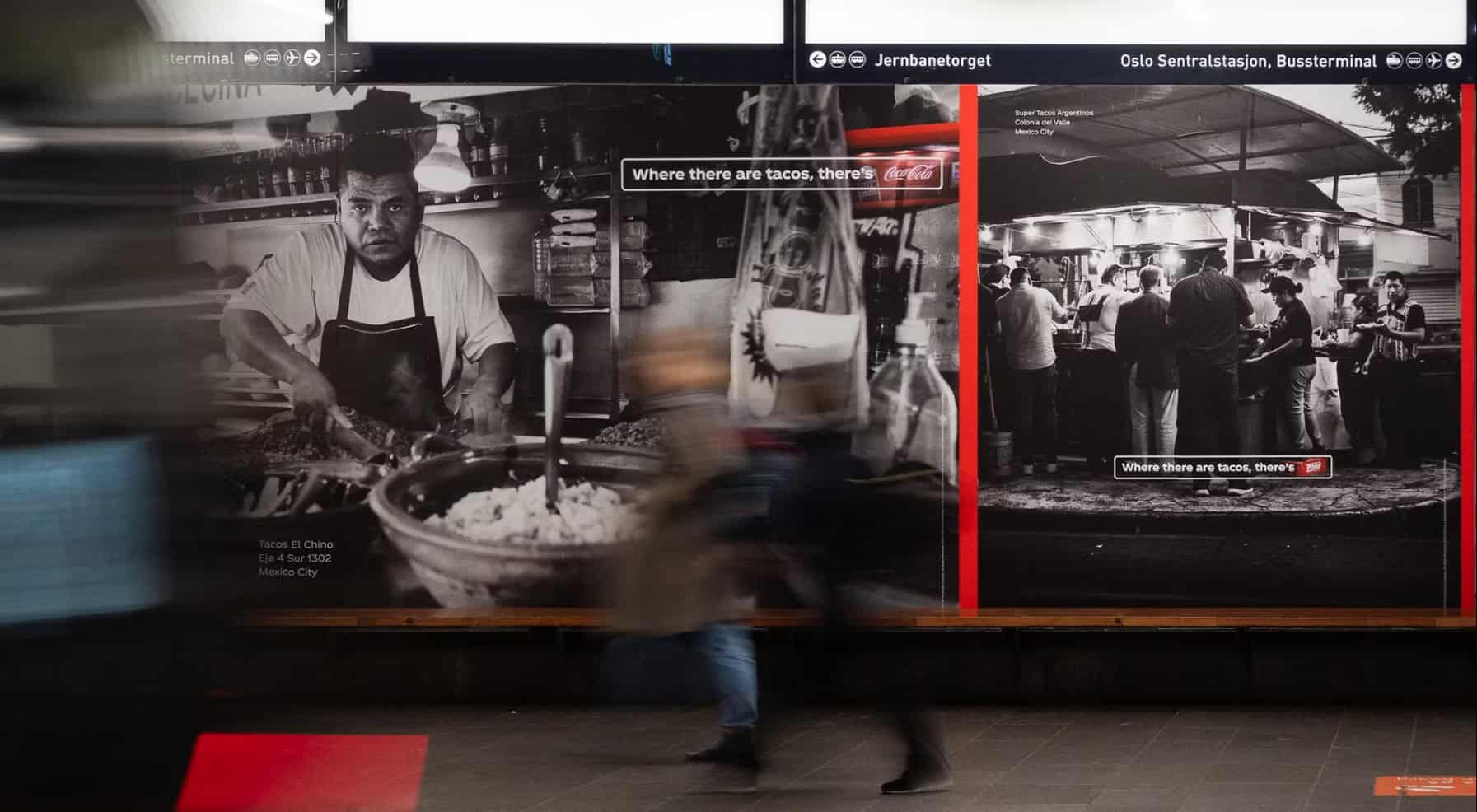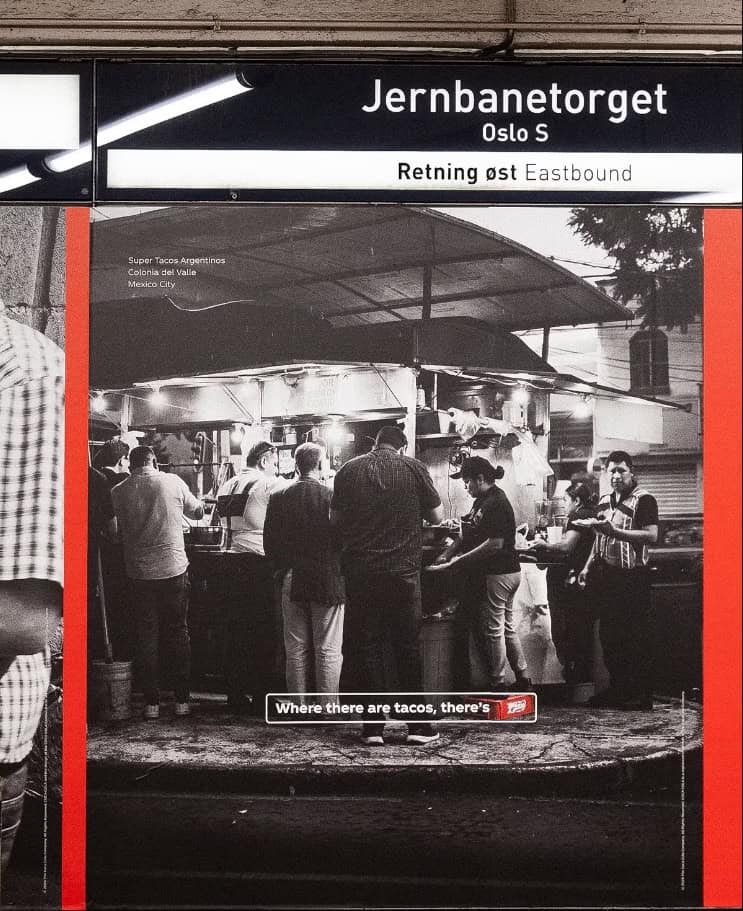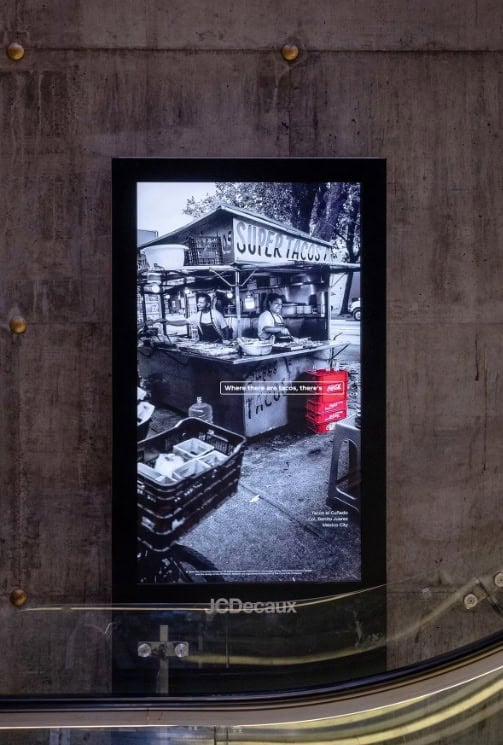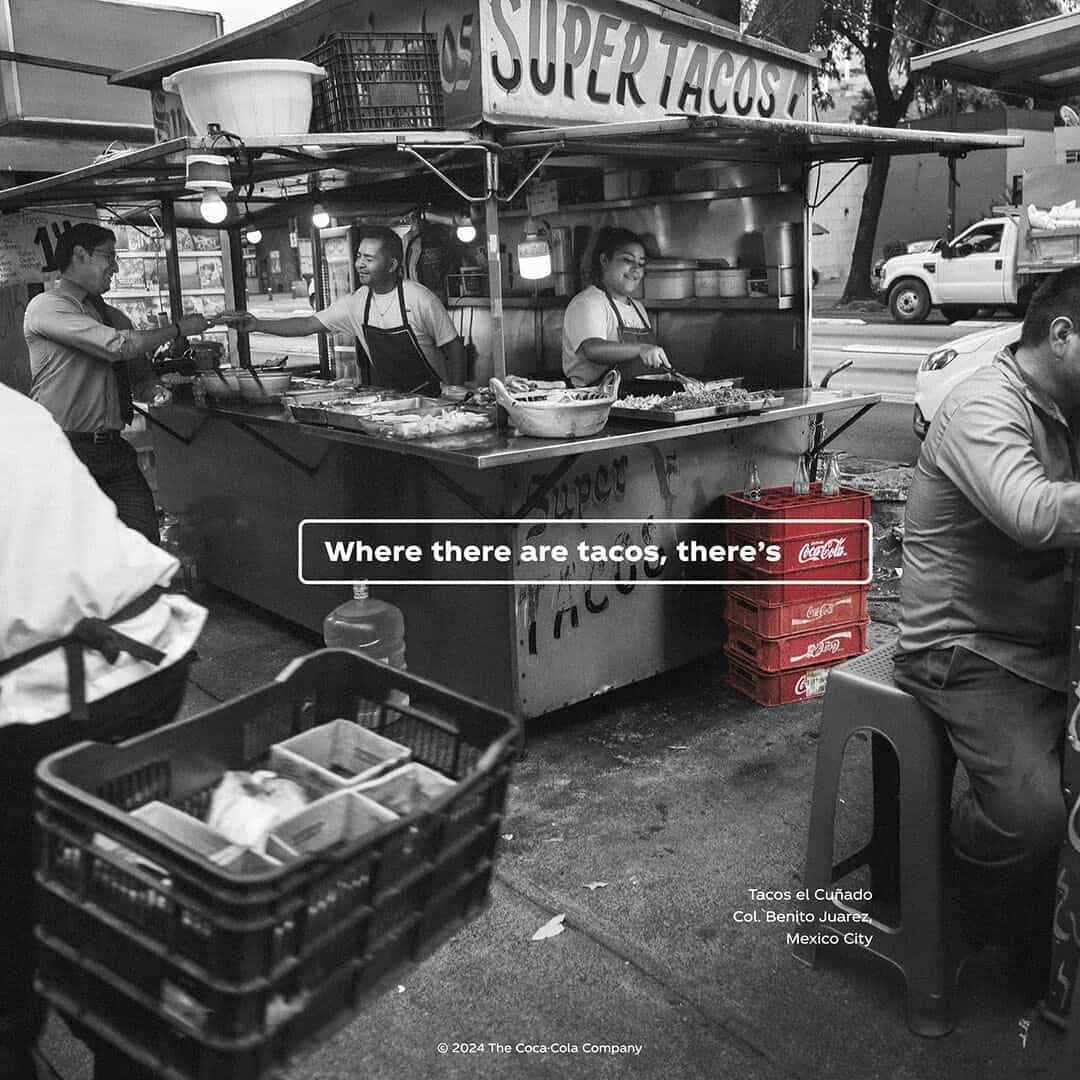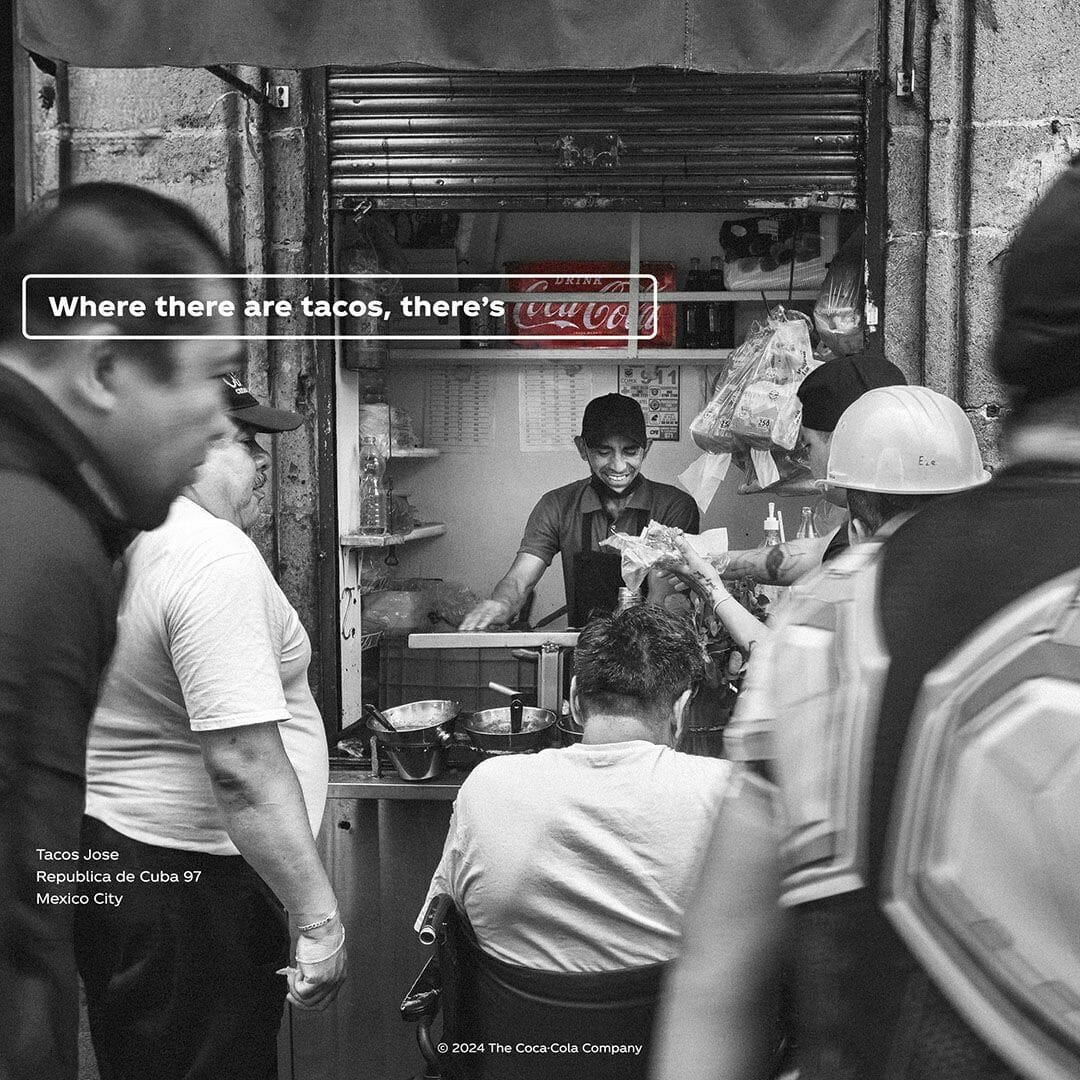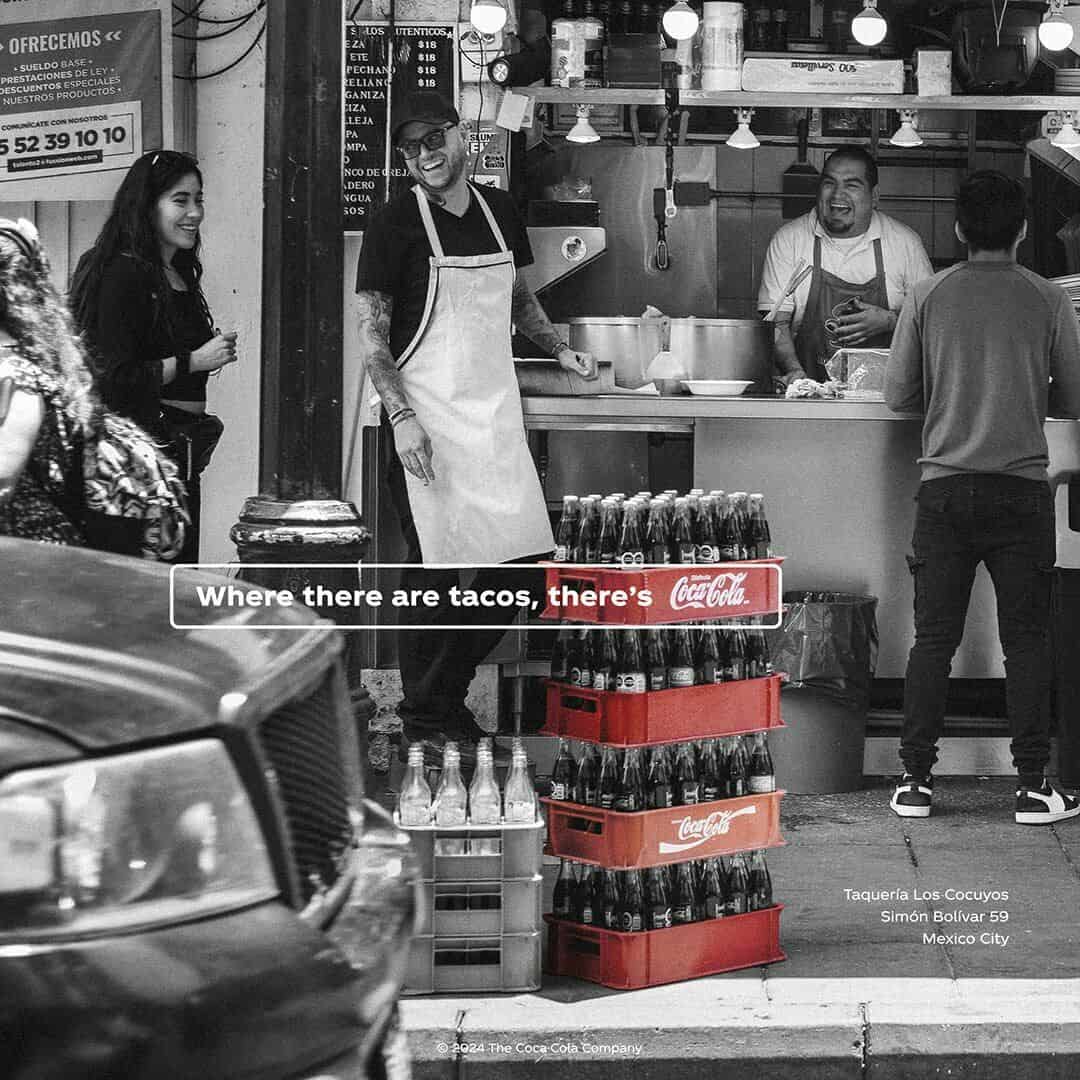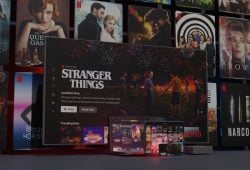In a bold display of advertising ingenuity, Coca-Cola has launched a campaign in Norway that transcends conventional marketing boundaries, masterfully fusing Mexican tacos with Scandinavian idiosyncrasy. This initiative, orchestrated by Uncommon Stockholm, not only redefines the association between the iconic beverage and Mexican gastronomy but also erects a cultural bridge between continents, challenging traditional perceptions of global advertising.
Visual Alchemy: Mexico in Black, White, and Red
Photographer Frederik Trovatten, with his keen lens and experiential knowledge of Mexico City, captures the very essence of Mexican streets. His images, stripped of color save for Coca-Cola’s emblematic red, are not mere photographs; they are windows into a world where the everyday transmutes into art. The decision to present scenes in black and white, with the subtle yet powerful intrusion of Coca-Cola red, is a visual tour de force that elevates the campaign from mere advertisement to artistic statement.
This chromatic choice is not casual. Black and white evoke a sense of timelessness, of historical authenticity, while Coca-Cola’s vibrant red bursts into this monochromatic palette as a symbol of modernity and vitality. It’s a visual metaphor for how the brand integrates into centuries-old traditions, respecting them while also invigorating them.
Subtlety as Supreme Strategy
In an era where advertising bombardment is omnipresent, Coca-Cola opts for strategic minimalism. The brand’s presence in the images is almost ghostly: inverted boxes, partially hidden logos. This apparent negligence is, in reality, a display of corporate confidence. Coca-Cola doesn’t need to shout its name; its mere suggestion is enough to evoke a universe of associations in the collective imagination.
This “less is more” strategy reflects a deep understanding of contemporary consumer psychology. In a world saturated with advertising messages, subtlety becomes a luxury, a form of respect for the viewer’s intelligence. Coca-Cola doesn’t underestimate its audience; on the contrary, it invites them to participate in a game of discovery and association.
The Nordic Paradox: Tacos in the Land of Fjords
The choice of Norway as the setting for this campaign is not fortuitous. The concept of “Taco Friday” in Nordic countries is more than a passing fad; it’s a social ritual that has taken deep root in local culture. Coca-Cola, with anthropological sagacity, exploits this cultural peculiarity to insert its product into a context that, at first glance, might seem incongruous. However, it is precisely this apparent discord that gives the campaign its subversive force.
This phenomenon of “Taco Friday” in Scandinavia deserves deeper analysis. How has a Mexican culinary tradition become a pillar of Nordic social life? It’s a fascinating example of cultural globalization, where culinary borders blur and redefine themselves. Coca-Cola, by linking its brand with this hybrid tradition, not only sells a product but positions itself as a bridge between cultures, a facilitator of global experiences.
Authenticity as a Weapon of Mass Seduction
In a world saturated with artifice, authenticity has become the new currency of the advertising realm. Coca-Cola, by presenting raw, unretouched scenes of everyday Mexican life, is not just selling a product; it’s selling an experience, a sensory journey to the streets of Mexico. This strategy appeals to an increasingly sophisticated consumer who values veracity over prefabricated glamour.
The pursuit of authenticity in advertising is not new, but Coca-Cola takes it to a new level. It’s not simply about showing “real” scenes; it’s a careful curation of moments that, although everyday, are loaded with cultural significance. Each image is a narrative in itself, telling stories of tradition, community, and the simple pleasure of sharing a meal.
The Power of Association: Coca-Cola as a Universal Complement
The slogan “Where there are tacos, there’s Coca-Cola” is a bold but effective statement. It establishes a symbiotic relationship between Mexican food and the drink, suggesting that one is not complete without the other. This association transcends cultural boundaries; whether you’re in Mexico City or Oslo, the combination of tacos and Coca-Cola is presented as a universal constant.
This association strategy has profound psychological ramifications. Coca-Cola is not just selling itself as a beverage, but as an integral part of a culinary and cultural experience. It’s an exercise in conditioning on a global scale: every time someone thinks of tacos, the subconscious will evoke the image of a Coca-Cola, and vice versa.
Globalization on the Plate: Cultural Implications
Coca-Cola’s campaign is a microcosm of broader trends in cultural globalization. It raises fascinating questions about authenticity in an interconnected world. What does it mean that a Mexican dish has become a Scandinavian tradition? How does the meaning of “authenticity” change when cultures merge and evolve?
Coca-Cola, in this context, positions itself not just as a product, but as an agent of cultural change. The brand presents itself as a unifying element, a common denominator in a world of cultural differences. It’s a powerful narrative that transcends the simple act of selling a drink.
The Art of Subliminal Persuasion
The campaign is a case study in subliminal persuasion. By minimizing the explicit presence of the brand, Coca-Cola maximizes its psychological impact. The images don’t shout “buy Coca-Cola”; they whisper “Coca-Cola is part of this special moment.” It’s an approach that respects consumer intelligence and, paradoxically, can be more effective than more aggressive tactics.
This subtle approach also reflects a sophisticated understanding of how memory and association work. The images, with their emotional and cultural charge, are more likely to stick in the viewer’s mind than a traditional advertisement. Coca-Cola isn’t selling a product; it’s creating memories and positive associations.
The Triumph of Subtlety in the Era of Media Saturation
This Coca-Cola campaign is a paradigm of how contemporary advertising can transcend its own limits. It’s not simply an advertisement; it’s a social commentary, an intercultural bridge, and a visual work of art. By minimizing its explicit presence, Coca-Cola maximizes its subliminal impact. It’s a reminder that, in today’s saturated media landscape, sometimes the whisper is more effective than the shout.
The campaign also raises questions about the future of global marketing. Is this “less is more” approach the way forward in a world where consumers are increasingly tired of traditional advertising? How can global brands maintain their identity while adapting to specific cultural contexts?
Ultimately, this campaign doesn’t just sell soft drinks; it sells an idea, an experience, a fragment of Mexico transplanted to Norway. It’s a testament to the power of marketing to not only reflect culture but to shape and redefine it. Coca-Cola, once again, demonstrates why it’s a titan not just of the beverage industry, but of the art of global persuasion.
Coca-Cola’s campaign in Norway is more than a series of advertisements; it’s a mirror reflecting the complexities of our globalized world. It’s a reminder that, in the right hands, advertising can transcend its commercial function and become a significant cultural commentary. In a world where cultural boundaries are increasingly blurring, Coca-Cola doesn’t just adapt to change; it embraces and celebrates it, inviting us all to be part of a truly global experience.



